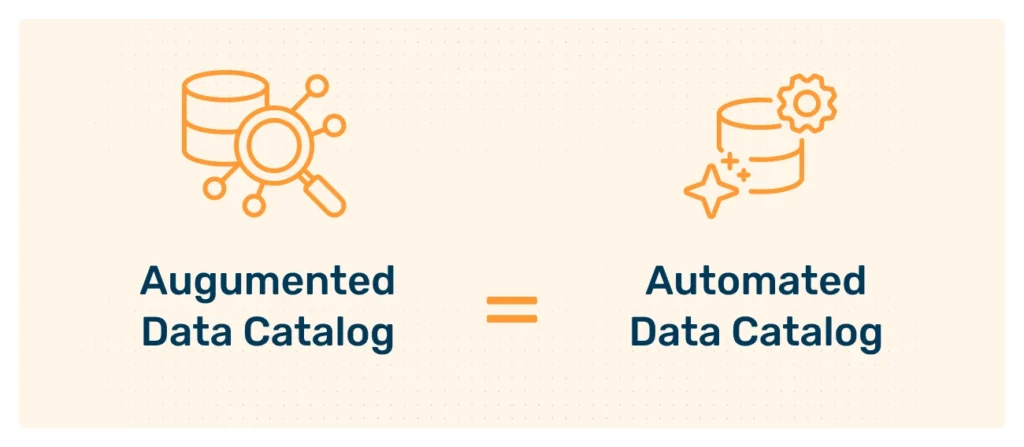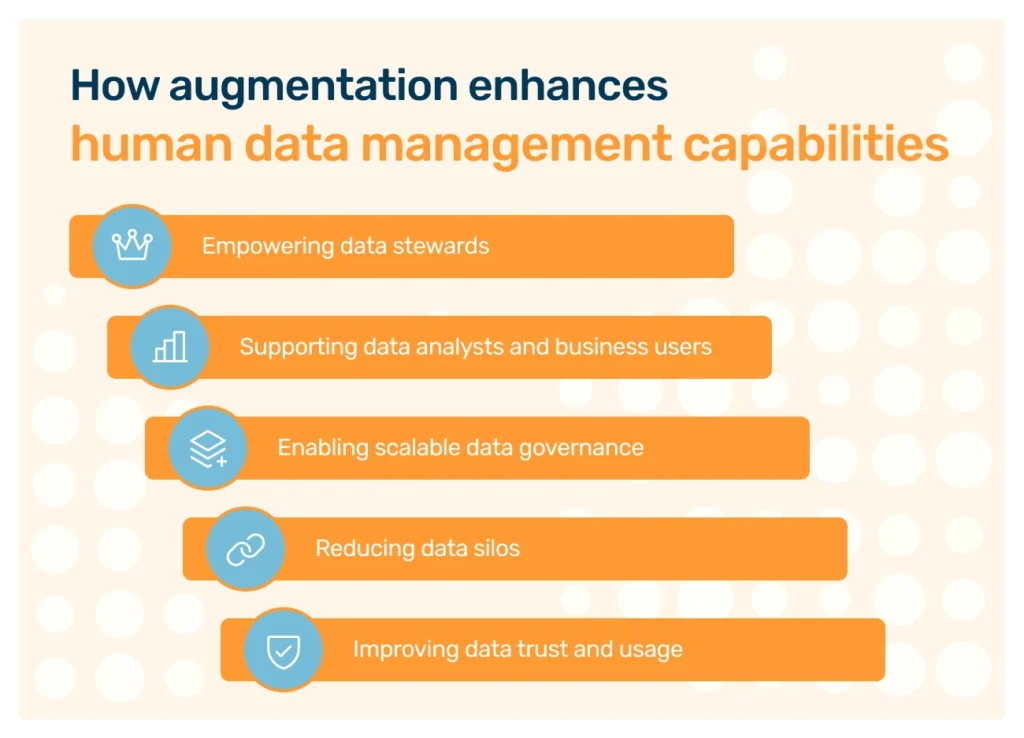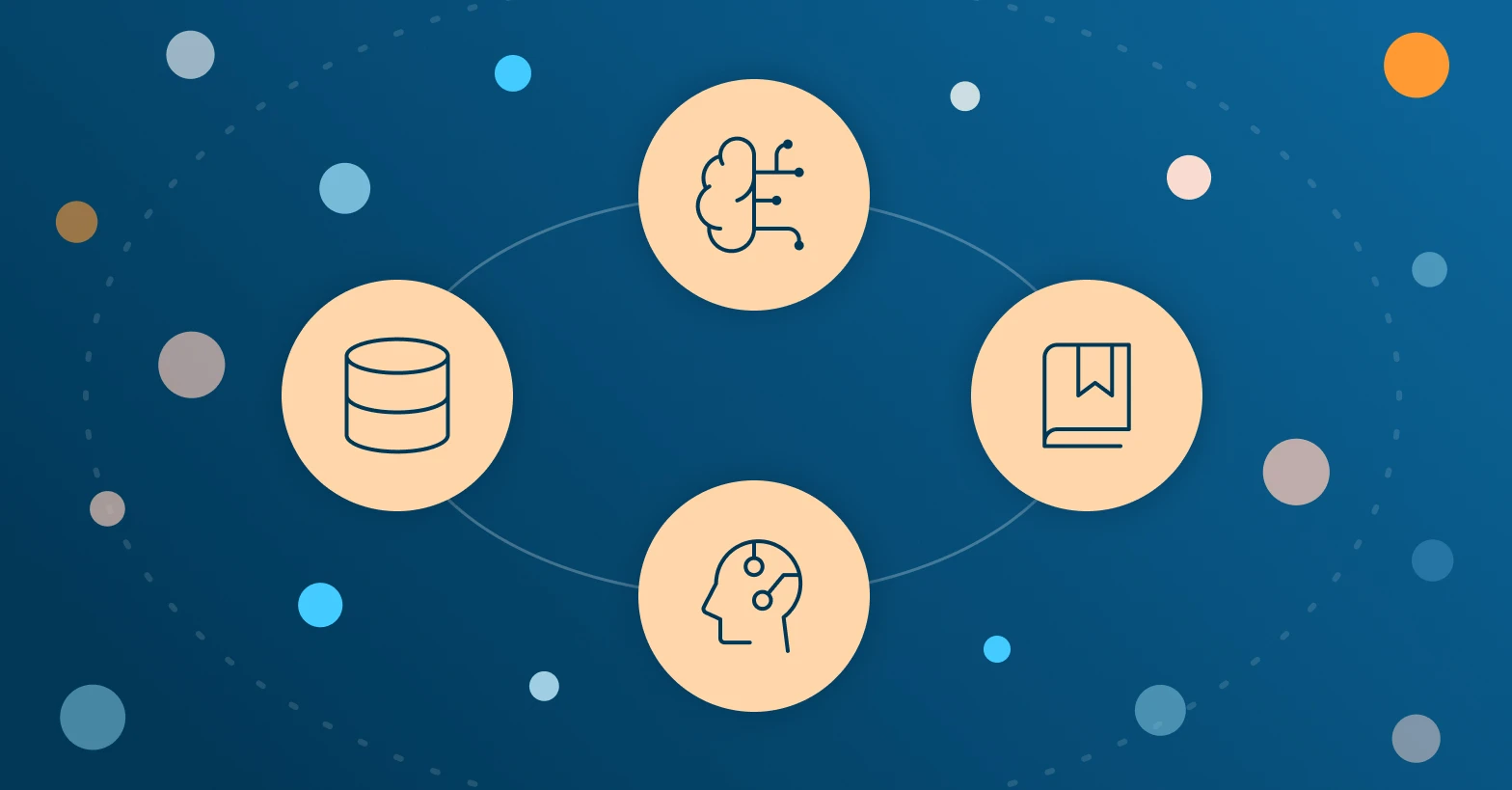Augmented data catalogs are next-generation tools that bridge the gap between human expertise and machine intelligence, combining human insight with AI-powered automation. Let’s take a closer look at what they do and what makes a data catalog “augmented” in the first place.
The evolution from traditional to augmented data catalogs
Augmented data catalogs (sometimes called automated data catalogs) are advanced data catalogs using artificial intelligence and machine learning to automate different aspects of metadata management.

A few years ago, a data catalog was little more than a searchable inventory of metadata, and a way to find and organize your data assets. It helped data teams navigate massive amounts of information scattered across the enterprise. But big data environments grew more complex, and the pressure to be data-driven increased. And so, the limitations of static, manually updated catalogs became really clear.
Traditional data catalogs required significant manual effort from data stewards and often became outdated pretty quickly, especially in dynamic, multi-source data environments. You couldn’t automate tagging, classification, or anomaly detection. On the other hand, with modern data catalogs that use machine learning and AI, it’s easy to automatically update metadata, flag data errors, and simplify data discovery.
According to Gartner’s report from a few years back, organizations are increasingly turning to AI-augmented data catalogs as foundational elements of data governance and analytics strategies. And that’s only increased today.
In fact, Gartner’s 2025 Magic Quadrant for Augmented Data Quality Solutions highlights a shift toward augmented metadata and AI-assisted data discovery as critical for scaling data trust and accelerating business outcomes.
“Scaling data quality is increasingly dependent upon augmented, two‑way data flow with data governance platforms.” Gartner
So, what do augmented data catalogs really augment? They augment human capabilities by automating tasks such as making smart recommendations, detecting usage patterns, and providing up-to-date insights across an organization’s data.
Core components that define modern augmented data catalogs
A modern data catalog is no longer just a passive reference tool. It’s an active participant in your data management lifecycle. The core features of an augmented data catalog include:
1. Automated metadata ingestion and classification
Instead of relying only on manual input, augmented data catalogs use machine learning to identify and classify data assets. This way, they reduce human effort and automate the repetitive parts of cataloging.
2. AI-driven data discovery
An AI-augmented data catalog learns from usage behavior, so it can suggest relevant data sets, related assets, or even spot data lineage patterns that help users trace the flow of information across systems.
3. Natural language search
Searching within the catalog becomes more intuitive through natural language capabilities. This makes it infinitely easier for non-technical users to search for data and understand what’s available without knowing the exact schema or field names, significantly improving enterprise-wide data accessibility.
In fact, the entire user interface is usually more intuitive and usable.
4. Data quality and error detection
Integrated data quality checks and anomaly detection tools automatically identify data errors or inconsistencies. This is really helpful in maintaining trust in analytics and reporting.
5. Collaboration and stewardship support
An augmented data catalog supports data stewardship by assigning roles, tracking contributions, and facilitating collaboration. For example, Collibra’s guided stewardship features are widely used to manage data stewardship programs in large enterprises.
How augmentation enhances human data management capabilities

When we’re talking about enterprise data catalogs, automation is essential. But the real power of augmented data catalogs lies in their ability to enhance, not replace, human roles. Here’s how they support people within an organization:
Empowering data stewards
By automating tagging, classification, and validation tasks, tools like Collibra give data stewards more time to focus on data definitions, business context, and policy enforcement.
Supporting data analysts and business users
Augmented data catalogs make it easier for data analysts and business users to independently access curated, trusted data assets, reducing time spent chasing datasets or validating quality.
Enabling scalable data governance
Modern data governance tools embed policies, roles, and workflows into the catalog, making compliance and data ownership scalable as organizations grow.
Reducing data silos
By connecting disparate tools and platforms into a single, governed data catalog, tools like Collibra help eliminate silos and surface previously hidden datasets (including unstructured data) that can fuel effective data and analytics initiatives.
Improving data trust and usage
The combination of data lineage, steward annotations, and data quality metrics within the catalog builds trust across the organization, encouraging more widespread and confident data-driven decision-making.
Selection criteria: finding the right augmented data catalog for your organization
With so many vendors claiming to offer augmented or AI-powered catalogs, how do you know which one is right for your business? Here are key factors to consider, illustrated by what platforms like Collibra provide:
1. Level of automation and intelligence
Look for tools that go beyond indexing. A true augmented data catalog like Collibra uses advanced machine learning to power recommendations, profiling, and automated data lineage mapping.
2. Integration capabilities
Your data catalog should integrate with major data management platforms, data lakes, BI tools, and privacy solutions. For example, Collibra offers connectors to Snowflake, Databricks, Tableau, and more, making it enterprise-ready. (Plus, we can integrate basically any system with Collibra during custom development.)
3. Support for data stewardship and governance
Look for built-in tools to manage data stewardship programs, define ownership, track responsibilities, and enforce policies, all within the catalog UI.
4. Usability and search features
An augmented data catalog should be easy to use for people with different skill levels. To do this, a business-oriented UI is essential, and so is using natural language processing for search.
5. Scalability and performance
Choose a data catalog that’s built to support the metadata management needs of complex enterprises, with a scalable architecture that maintains performance as data volumes grow.
6. Vendor credibility and roadmap
You can take a look at Gartner’s Magic Quadrant for data governance platforms, or talk to us to find the optimal match for your organization’s needs.
7. Demonstrated value
Look at past clients and available numbers to get an idea of what you can expect. At Murdio, we can also help you evaluate those.
For example, according to research by Collibra and IDC, Collibra contributes an average of $784,000 in added value annually for organizations.
So, while evaluating your options, definitely evaluate what you want your organization to gain, and how an augmented data catalog can help achieve that.
Read more: Data catalog requirements
The bottom line (pun intended)
Data complexity keeps increasing; we don’t have to tell anyone that. Between legacy systems and multiple (often duplicate) data sources and formats, relying solely on manual cataloging and traditional tools is no longer sustainable.
An augmented data catalog represents the next logical step in building a resilient, agile data management strategy. Because it blends automation with human expertise, it lets organizations automate routine tasks, reduce data errors, and empower users to work smarter with their data assets.
FAQ
What is an augmented data catalog?
An augmented data catalog is a modern data catalog that uses artificial intelligence (AI) and machine learning (ML) to automate metadata discovery, classification, and management. Unlike traditional catalogs, it can augment human efforts by suggesting relevant data, detecting data errors, and helping maintain data quality across the organization.
Is AI and ML the same in data catalogs?
No, they have distinct roles. Think of AI as the ‘what’ and ML as the ‘how’. The ‘what’ (AI) is the goal: creating intelligent management tools that simplify data discovery. The ‘how’ (ML) is the engine that powers this intelligence.
In these systems, AI and ML are partners. ML models use data from usage logs to find connections within complex data ecosystems, enabling the AI to provide smarter search results and recommendations.
How do data catalogs help in detecting data errors?
Data catalogs help detect errors by actively profiling assets across the entire data landscape. Using AI, they automatically scan for anomalies like unexpected nulls, format deviations, or statistical outliers that don’t match historical patterns.
This proactive monitoring flags potential issues at the source, contributing to better data quality and increasing trust. By providing this layer of automated oversight, catalogs ensure that when users search for information, they are more likely to find and use the right data for analysis.
How does an augmented data catalog differ from a traditional catalog?
A traditional data catalog relies heavily on manual input and updates, and an augmented data catalog automates many of those tasks using AI. It helps organizations discover, profile, and govern their data assets more efficiently, reducing the risk of data errors and improving data stewardship.
Why is automation important in data cataloging?
Automation helps data catalogs scale. With data growing across multiple systems and environments, manually managing metadata is no longer feasible. An automated data catalog simplifies the process, because it continuously updates metadata, profiles data, and detects anomalies without constant human intervention.
What are the benefits of using Collibra as an augmented data catalog?
Collibra offers a comprehensive modern data catalog solution with built-in governance, data quality monitoring, and AI-powered search. It enables organizations to automate data discovery, support data stewardship programs, and maintain effective data governance at scale.
How do augmented data catalogs support data governance?
By embedding governance policies, roles, and workflows directly into the catalog interface, augmented data catalogs like Collibra help make sure definitions are consistent, ownership is clear, and compliance is enforced. They provide visibility into data lineage, data access, and data usage across the organization.
Share this article
Related Articles
See all-

15 November 2025
| Collibra experts for hireWhat is Collibra Edge? A 2025 Explainer
-

15 November 2025
| Collibra experts for hireThe definitive guide to Collibra Data Lineage
-

3 November 2025
| Collibra experts for hireCase Study: Discovering, classifying and cataloging unstructured data for a European bank



